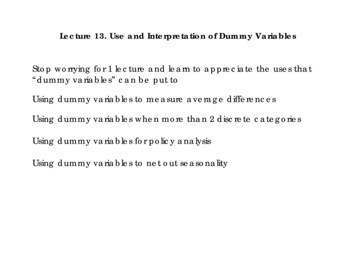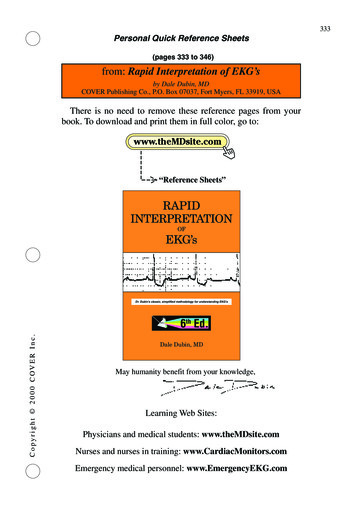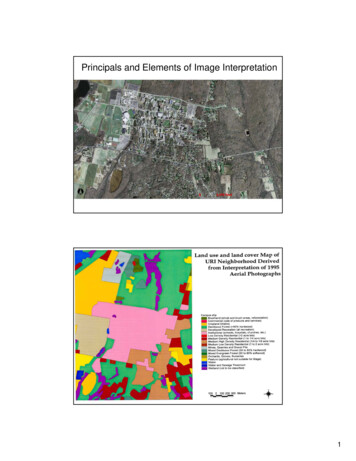
Transcription
Lecture 13. Use and Interpretation of Dummy VariablesStop worrying for 1 lecture and learn to appreciate the uses that“dummy variables” can be put toUsing dummy variables to measure average differencesUsing dummy variables when more than 2 discrete categoriesUsing dummy variables for policy analysisUsing dummy variables to net out seasonality
Use and Interpretation of Dummy VariablesDummy variables – where the variable takes only one of twovalues – are useful tools in econometrics, since often interested invariables that are qualitative rather than quantitative
Use and Interpretation of Dummy VariablesDummy variables – where the variable takes only one of twovalues – are useful tools in econometrics, since often interested invariables that are qualitative rather than quantitativeIn practice this means interested in variables that split the sampleinto two distinct groups in the following way
Use and Interpretation of Dummy VariablesDummy variables – where the variable takes only one of twovalues – are useful tools in econometrics, since often interested invariables that are qualitative rather than quantitativeIn practice this means interested in variables that split the sampleinto two distinct groups in the following wayD 1if the criterion is satisfied
Use and Interpretation of Dummy VariablesDummy variables – where the variable takes only one of twovalues – are useful tools in econometrics, since often interested invariables that are qualitative rather than quantitativeIn practice this means interested in variables that split the sampleinto two distinct groups in the following wayD 1D 0if the criterion is satisfiedif not
Use and Interpretation of Dummy VariablesDummy variables – where the variable takes only one of twovalues – are useful tools in econometrics, since often interested invariables that are qualitative rather than quantitativeIn practice this means interested in variables that split the sampleinto two distinct groups in the following wayD 1D 0if the criterion is satisfiedif notEg. Male/Female
Use and Interpretation of Dummy VariablesDummy variables – where the variable takes only one of twovalues – are useful tools in econometrics, since often interested invariables that are qualitative rather than quantitativeIn practice this means interested in variables that split the sampleinto two distinct groups in the following wayD 1D 0if the criterion is satisfiedif notEg. Male/Femaleso that the dummy variable “Male” would be coded1 if male
Use and Interpretation of Dummy VariablesDummy variables – where the variable takes only one of twovalues – are useful tools in econometrics, since often interested invariables that are qualitative rather than quantitativeIn practice this means interested in variables that split the sampleinto two distinct groups in the following wayD 1D 0if the criterion is satisfiedif notEg. Male/Femaleso that the dummy variable “Male” would be coded1 if maleand 0 if female
Use and Interpretation of Dummy VariablesDummy variables – where the variable takes only one of twovalues – are useful tools in econometrics, since often interested invariables that are qualitative rather than quantitativeIn practice this means interested in variables that split the sampleinto two distinct groups in the following wayD 1D 0if the criterion is satisfiedif notEg. Male/Femaleso that the dummy variable “Male” would be coded1 if maleand 0 if female(though could equally create another variable “Female” coded 1if female and 0 if male)
Example: Suppose we are interested in the gender pay gap
Example: Suppose we are interested in the gender pay gapModel isLnW b0 b1Age b2Malewhere Male 1 or 0
Example: Suppose we are interested in the gender pay gapModel isLnW b0 b1Age b2Malewhere Male 1 or 0For men therefore the predicted wage LnWmen b 0 b1 Age b 2 * (1)
Example: Suppose we are interested in the gender pay gapModel isLnW b0 b1Age b2Malewhere Male 1 or 0For men therefore the predicted wage LnWmen b 0 b1 Age b 2 * (1) b 0 b1 Age b 2
Example: Suppose we are interested in the gender pay gapModel isLnW b0 b1Age b2Malewhere Male 1 or 0For men therefore the predicted wage LnWmen b 0 b1 Age b 2 * (1) b 0 b1 Age b 2For women LnW women b 0 b1 Age b 2 * (0)
Example: Suppose we are interested in the gender pay gapModel isLnW b0 b1Age b2Malewhere Male 1 or 0For men therefore the predicted wage LnWmen b 0 b1 Age b 2 * (1) b 0 b1 Age b 2For women LnW women b 0 b1 Age b 2 * (0) b 0 b1 Age
Remember that OLS predicts the mean or average value of thedependent variableYˆ Y(see lecture 2)So in the case of a regression model with log wages as thedependent variable, LnW b0 b1Age b2Malethe average of the fitted values equals the average of log wages Ln(W ) LnW
Remember that OLS predicts the mean or average value of thedependent variableYˆ Y(see lecture 2)
Remember that OLS predicts the mean or average value of thedependent variableYˆ Y(see lecture 2)So in the case of a regression model with log wages as thedependent variable, LnW b0 b1Age b2Male
Remember that OLS predicts the mean or average value of thedependent variableYˆ Y(see lecture 2)So in the case of a regression model with log wages as thedependent variable, LnW b0 b1Age b2Malethe average of the fitted values equals the average of log wages Ln(W ) LnW
So the (average) difference in pay between men and women isthenLnWmen – LnWwomen
So the (average) difference in pay between men and women is thenLnWmen – LnWwomen LnW men LnW women
So the (average) difference in pay between men and women is thenLnWmen – LnWwomen LnW men LnW women b 0 b1 Age b 2 b 0 b1 Age
The (average) difference in pay between men and women is thenLnWmen – LnWwomen LnW men LnW women b 0 b1 Age b 2 b 0 b1 Age b2which is just the coefficient on the male dummy variable
The (average) difference in pay between men and women is thenLnWmen – LnWwomen LnW men LnW women b 0 b1 Age b 2 b 0 b1 Age b2which is just the coefficient on the male dummy variableIt also follows that the constant, b0, measures the intercept of defaultgroup (women) with age set to zero and b0 b2 is the intercept for men
The (average) difference in pay between men and women is thenLnWmen – LnWwomen LnW men LnW women b 0 b1 Age b 2 b 0 b1 Age b 2 b2which is just the coefficient on the male dummy variable
So the coefficients on dummy variables measure the average differencebetween the group coded with the value “1”and the group coded with the value “0” (the “default” or “base group” )
It also follows that the constant, b0, now measures the notional value ofthe dependent variable (in this case log wages) of the default group (inthis case women) with age set to zeroand b0 b2 is the intercept and notional value of log wages at age zerofor men
So to measure average difference between two groupsLnW β0 β1Group DummyMenLnWB0 B1B0Β1Women
A simple regression of the log of hourly wages on age using the data set ps4data.dta gives. reg lhwage ageSource SSdfMSNumber of obs 12098--------- -----------------------------F( 1, 12096) 235.55Model 75.43347571 75.4334757Prob F 0.0000Residual 3873.61564 12096 .320239388R-squared 0.0191--------- -----------------------------Adj R-squared 0.0190Total 3949.04911 12097 .326448633Root MSE --------------------------------lhwage Coef.Std. Err.tP t [95% Conf. Interval]--------- -----------------age .0070548.000459715.3480.000.0061538.0079558cons 1.693719.018694590.6000.0001.6570751.730364Now introduce a male dummy variable (1 male, 0 otherwise) as an intercept dummy. This specification says the slopeeffect (of age) is the same for men and women, but that the intercept (or the average difference in pay between men andwomen) is different.reg lhw age maleSource SSdfMSNumber of obs 12098------------- -----------------------------F( 2, 12095) 433.34Model 264.0530532 132.026526Prob F 0.0000Residual 3684.99606 12095 .304671026R-squared 0.0669------------- -----------------------------Adj R-squared 0.0667Total 3949.04911 12097 .326448633Root MSE ---------------------------------lhw Coef.Std. Err.tP t [95% Conf. Interval]------------- -------------age .0066816.000448614.890.000.0058022.0075609male .2498691.010042324.880.000.2301846.2695537cons rage wage difference between men and women (b0 – (b0 b2) b2 25% more on average
Note that if we define a dummy variables as female (1 female, 0 otherwise) then. reg lhwage age femaleSource SSdfMSNumber of obs 12098--------- -----------------------------F( 2, 12095) 433.34Model 264.0530532 132.026526Prob F 0.0000Residual 3684.99606 12095 .304671026R-squared 0.0669--------- -----------------------------Adj R-squared 0.0667Total 3949.04911 12097 .326448633Root MSE ---------------------------------lhwage Coef.Std. Err.tP t [95% Conf. Interval]--------- -----------------age .0066816.000448614.8940.000.0058022.0075609female s 1.833721.019082996.0930.0001.7963161.871127The coefficient estimate on the dummy variable is the same but the sign of the effect is reversed (now negative). This isbecause the reference (default) category in this regression is now menModel is nowLnW b0 b1Age b2femaleso constant, b0, measures average earnings of default group (men)and b0 b2 is average earnings of womenSo nowaverage wage difference between men and women (b0 – (b0 b2) b2 -25% less on averageHence it does not matter which way the dummy variable is defined as long as you are clear as to the appropriatereference category.
2) To measure Difference in Slope Effects between two groupsLnW β0 β1Group Dummy*Slope VariableMenLnWβ1*Age2Womenβ1*Age1Age1Age2(Dummy Variable Interaction Term)Age
We need to consider an interaction term – multiply slope variable (age)by dummy variable.
Now consider an interaction term – multiply slope variable (age) bydummy variable.Model is nowLnW b0 b1Age b2Female*Age
Now consider an interaction term – multiply slope variable (age) bydummy variable.Model is nowLnW b0 b1Age b2Female*AgeThis means that (slope) age effect is different for the 2 groups
Now consider an interaction term – multiply slope variable (age) bydummy variable.LnW b0 b1Age b2Female*AgeModel is nowThis means that (slope) age effect is different for the 2 groupsdLnW/dAge b1if female 0
Now consider an interaction term – multiply slope variable (age) bydummy variable.Model is nowLnW b0 b1Age b2Female*AgeThis means that (slope) age effect is different for the 2 groupsdLnW/dAge b1 b1 b2if female 0if female 1
. g femage female*age/* command to create interaction term */. reg lhwage age femageSource SSdfMSNumber of obs 12098--------- -----------------------------F( 2, 12095) 467.35Model 283.2892492 141.644625Prob F 0.0000Residual 3665.75986 12095.3030806R-squared 0.0717--------- -----------------------------Adj R-squared 0.0716Total 3949.04911 12097 .326448633Root MSE ---------------------------------lhwage Coef.Std. Err.tP t [95% Conf. Interval]--------- -----------------age .0096943.000458421.1480.000.0087958.0105929femage -.006454.0002465-26.1880.000-.0069371-.005971cons 1.715961.018206694.2490.0001.6802731.751649So effect of 1 extra year of age on earnings .0097 if male (.0097 - .0065) if femaleCan include both an intercept and a slope dummy variable in the same regression to decide whether differences werecaused by differences in intercepts or the slope variables. reg lhwage age female femageSource SSdfMSNumber of obs 12098--------- -----------------------------F( 3, 12094) 311.80Model 283.5068573 94.5022855Prob F 0.0000Residual 3665.54226 12094 .303087668R-squared 0.0718--------- -----------------------------Adj R-squared 0.0716Total 3949.04911 12097 .326448633Root MSE ---------------------------------lhwage Coef.Std. Err.tP t [95% Conf. Interval]--------- -----------------age .0100393.000613116.3760.000.0088376.011241female .0308822.03644650.8470.397-.0405588.1023233femage -.0071846.0008968-8.0120.000-.0089425-.0054268cons 1.701176.025218667.4570.0001.6517431.750608In this example the average differences in pay between men and women appear to be driven by factors which cause theslopes to differ (ie the rewards to extra years of experience are much lower for women than men)- Note that this model isequivalent to running separate regressions for men and women – since allowing both intercept and slope to vary
Using & Understanding Dummy VariablesTo measure average difference between two groupsLnW β0 β1Group DummyMenLnWΒ1Women
2) To measure Difference in Slope Effects between two groupsLnW β0 β1Group Dummy*Slope VariableMenLnWβ1*Age2Womenβ1*Age1Age1Age2(Dummy Variable Interaction Term)Age
The Dummy Variable TrapThe general principle of dummy variables can be extended to caseswhere there are several (but not infinite) discrete groups/categories
The Dummy Variable TrapThe general principle of dummy variables can be extended to caseswhere there are several (but not infinite) discrete groups/categoriesIn general just define a dummy variable for each category
The Dummy Variable TrapThe general principle of dummy variables can be extended to caseswhere there are several (but not infinite) discrete groups/categoriesIn general just define a dummy variable for each categoryEg if no. groups 3 (North, Midlands, South)
The Dummy Variable TrapThe general principle of dummy variables can be extended to caseswhere there are several (but not infinite) discrete groups/categoriesIn general just define a dummy variable for each categoryEg if no. groups 3 (North, Midlands, South)Then defineDNorth 1 if live in the North, 0 otherwise
The Dummy Variable TrapThe general principle of dummy variables can be extended to caseswhere there are several (but not infinite) discrete groups/categoriesIn general just define a dummy variable for each categoryEg if no. groups 3 (North, Midlands, South)Then defineDNorthDMidlands 1 if live in the North, 0 otherwise 1 if live in the Midlands, 0 otherwise
The Dummy Variable TrapThe general principle of dummy variables can be extended to caseswhere there are several (but not infinite) discrete groups/categoriesIn general just define a dummy variable for each categoryEg if no. groups 3 (North, Midlands, South)Then defineDNorthDMidlandsDSouth 1 if live in the North, 0 otherwise 1 if live in the Midlands, 0 otherwise 1 if live in the South, 0 otherwise
The Dummy Variable TrapThe general principle of dummy variables can be extended to caseswhere there are several (but not infinite) discrete groups/categoriesIn general just define a dummy variable for each categoryEg if no. groups 3 (North, Midlands, South)Then defineDNorthDMidlandsDSouthHowever 1 if live in the North, 0 otherwise 1 if live in the Midlands, 0 otherwise 1 if live in the South, 0 otherwise
The Dummy Variable TrapThe general principle of dummy variables can be extended to caseswhere there are several (but not infinite) discrete groups/categoriesIn general just define a dummy variable for each categoryEg if no. groups 3 (North, Midlands, South)Then defineDNorthDMidlandsDSouth 1 if live in the North, 0 otherwise 1 if live in the Midlands, 0 otherwise 1 if live in the South, 0 otherwiseHoweverAs a rule should always include one less dummy variable in the modelthan there are categories, otherwise will introduce multicolinearity intothe model
Example of Dummy Variable TrapSuppose interested in estimating the effect of (5) different qualifications on payA regression of the log of hourly earnings on dummy variables for each of 5 education categories gives the followingoutput. reg lhwage age postgrad grad highint low noneSource SSdfMSNumber of obs 12098--------- -----------------------------F( 5, 12092) 747.70Model 932.6006885 186.520138Prob F 0.0000Residual 3016.44842 12092 .249458189R-squared 0.2362--------- -----------------------------Adj R-squared 0.2358Total 3949.04911 12097 .326448633Root MSE ---------------------------------lhwage Coef.Std. Err.tP t [95% Conf. Interval]--------- -----------------age .010341.000414824.9310.000.009528.0111541postgrad (dropped)grad nt -.4011569.0225955-17.7540.000-.4454478-.356866low e s 2.110261.025917481.4220.0002.0594592.161064
Since in this example there are 5 possible education categories(postgrad, graduate, higher intermediate, low and no qualifications)
Since in this example there are 5 possible education categories(postgrad, graduate, higher intermediate, low and no qualifications)5 dummy variables exhaust the set of possible categories,so the sum of these 5 dummy variables is always one for eachobservation in the data set.
Since in this example there are 5 possible education categories(postgrad, graduate, higher intermediate, low and no qualifications)5 dummy variables exhaust the set of possible categories,so the sum of these 5 dummy variables is always one for eachobservation in the data set.Obs. Constant postgrad grad higherlownoqualsSum
Since in this example there are 5 possible education categories(postgrad, graduate, higher intermediate, low and no qualifications)5 dummy variables exhaust the set of possible categories,so the sum of these 5 dummy variables is always one for eachobservation in the regression data set.Obs. Constant postgrad grad higher11100low0noquals0Sum
Since in this example there are 5 possible education categories(postgrad, graduate, higher intermediate, low and no qualifications)5 dummy variables exhaust the set of possible categories,so the sum of these 5 dummy variables is always one for eachobservation in the regression data set.Obs. Constant postgrad grad higher11100low0noquals0Sum1
Since in this example there are 5 possible education categories(postgrad, graduate, higher intermediate, low and no qualifications)5 dummy variables exhaust the set of possible categories,so the sum of these 5 dummy variables is always one for eachobservation in the regression data set.Obs. Constant postgrad grad higher1110021010low00noquals00Sum1
Since in this example there are 5 possible education categories(postgrad, graduate, higher intermediate, low and no qualifications)5 dummy variables exhaust the set of possible categories,so the sum of these 5 dummy variables is always one for eachobservation in the regression data set.Obs. Constant postgrad grad higher1110021010low00noquals00Sum11
Since in this example there are 5 possible education categories(postgrad, graduate, higher intermediate, low and no qualifications)5 dummy variables exhaust the set of possible categories,so the sum of these 5 dummy variables is always one for eachobservation in the regression data set.Obs. Constant postgrad grad higher111002101031000low000noquals001Sum111
Since in this example there are 5 possible education categories(postgrad, graduate, higher intermediate, low and no qualifications)5 dummy variables exhaust the set of possible categories,so the sum of these 5 dummy variables is always one for eachobservation in the regression data set.Obs. Constant postgrad grad higher111002101031000low000noquals001Sum111Given the presence of a constant using 5 dummy variables leads to puremulticolinearity, becuse the sum 1 which is the same as the value of theconstant)
Since in this example there are 5 possible education categories(postgrad, graduate, higher intermediate, low and no qualifications)5 dummy variables exhaust the set of possible categories,so the sum of these 5 dummy variables is always one for eachobservation in the regression data set.Obs. Constant postgrad grad higher111002101031000low000noquals001Sum111Given the presence of a constant using 5 dummy variables leads to puremulticolinearity, (the sum 1 value of the constant)
Since in this example there are 5 possible education categories(postgrad, graduate, higher intermediate, low and no qualifications)5 dummy variables exhaust the set of possible categories,so the sum of these 5 dummy variables is always one for eachobservation in the data set.Obs. Constant postgrad grad higher111002101031000low000noquals001Sum111Given the presence of a constant using 5 dummy variables leads to puremulticolinearity, (the sum 1 value of the constant)
Since in this example there are 5 possible education categories(postgrad, graduate, higher intermediate, low and no qualifications)5 dummy variables exhaust the set of possible categories,so the sum of these 5 dummy variables is always one for eachobservation in the data set.Obs. constant postgrad en the presence of a constant using 5 dummy variables leads to puremulticolinearity, (the sum 1 value of the constant)So can’t include all 5 dummies and the constant in the same model
Solution: drop one of the dummy variables. Then sum will no longerequal one for every observation in the data set.
Solution: drop one of the dummy variables. Then sum will no longerequal one for every observation in the data set.Suppose drop the no quals dummy in the example above, the model isthenObs. Constant postgrad grad111021013100higher000low000
Solution: drop one of the dummy variables. Then sum will no longerequal one for every observation in the data set.Suppose drop the no quals dummy in the example above, the model isthenObs. Constant postgrad grad111021013100higher000low000Sum of dummies
Solution: drop one of the dummy variables. Then sum will no longerequal one for every observation in the data set.Suppose drop the no quals dummy in the example above, the model isthenObs. Constant postgrad grad111021013100higher000low000Sum of dummies1
Solution: drop one of the dummy variables. Then sum will no longerequal one for every observation in the data set.Suppose drop the no quals dummy in the example above, the model isthenObs. Constant postgrad grad111021013100higher000low000Sum of dummies11
Solution: drop one of the dummy variables. Then sum will no longerequal one for every observation in the data set.Suppose drop the no quals dummy in the example above, the model isthenObs. Constant postgrad grad111021013100higher000low000Sum of dummies110
Solution: drop one of the dummy variables. Then sum will no longerequal one for every observation in the data set.Suppose drop the no quals dummy in the example above, the model isthenObs. Constant postgrad grad111021013100higher000low000Sum of dummies110and so the sum is no longer collinear with the constant
Solution: drop one of the dummy variables. Then sum will no longerequal one for every observation in the data set.Suppose drop the no quals dummy in the example above, the model isthenObs. Constant postgrad grad111021013100higher000low000Sum of dummies110and so the sum is no longer collinear with the constantDoesn’t matter which one you drop, though convention says drop thedummy variable corresponding to the most common category.
Solution: drop one of the dummy variables. Then sum will no longerequal one for every observation in the data set.Suppose drop the no quals dummy in the example above, the model isthenObs. Constant postgrad grad111021013100higher000low000Sum of dummies110and so the sum is no longer collinear with the constantDoesn’t matter which one you drop, though convention says drop thedummy variable corresponding to the most common category.However changing the “default” category does change the coefficients,since all dummy variables are measured relative to this default referencecategory
Example: Dropping the postgraduate dummy (which Stata did automatically before when faced with the dummy variabletrap) just replicates the above results. All the education dummy variables pay effects are measured relative to the missingpostgraduate dummy variable (which effectively is now picked up by the constant term). reg lhw age grad highint low noneSource SSdfMSNumber of obs 12098------------- -----------------------------F( 5, 12092) 747.70Model 932.6006885 186.520138Prob F 0.0000Residual 3016.44842 12092 .249458189R-squared 0.2362------------- -----------------------------Adj R-squared 0.2358Total 3949.04911 12097 .326448633Root MSE ---------------------------------lhw Coef.Std. Err.tP t [95% Conf. Interval]------------- -------------age .010341.000414824.930.000.009528.0111541grad t -.4011569.0225955-17.750.000-.4454478-.356866low -.6723372.0209313-32.120.000-.7133659-.6313086none -.9497773.0242098-39.230.000-.9972324-.9023222cons ents on education dummies are all negative since all categories earn less than the default group of postgraduatesChanging the default category to the no qualifications group gives. reg lhw age postgrad grad highint lowSource SSdfMSNumber of obs 12098------------- -----------------------------F( 5, 12092) 747.70Model 932.6006885 186.520138Prob F 0.0000Residual 3016.44842 12092 .249458189R-squared 0.2362------------- -----------------------------Adj R-squared 0.2358Total 3949.04911 12097 .326448633Root MSE ---------------------------------lhw Coef.Std. Err.tP t [95% Conf. Interval]------------- -------------age .010341.000414824.930.000.009528.0111541postgrad .9497773.024209839.230.000.9023222.9972324grad .8573589.018920445.310.000.8202718.894446highint .5486204.017410931.510.000.5144922.5827486low .2774401.015143918.320.000.2477555.3071246cons 1.160484.023124750.180.0001.1151561.205812and now the coefficients are all positive (relative to those with no quals.)
Dummy Variables and Policy AnalysisOne important practical use of a regression is to try and evaluate the“treatment effect” of a policy intervention.
3) To Measure Effects of Change in the Average Behaviour of two groups,one subject to a policy the other not (the Difference-in-Difference Estimator)MenLnWWomenΒ3Treatment/Policy affects only a sub-section of the populationEg A drug, EMA, Change in Tuition Fees, Minimum Wageand may lead to a change in behaviour for the treated group - ascaptured by a change in the intercept (or slope) after the intervention(treatment) takes place
Dummy Variables and Policy AnalysisOne important practical use of a regression is to try and evaluatethe “treatment effect” of a policy intervention.Usually this means comparing outcomes for those affected by apolicy that is of concern to economistsEg a law on taxing cars in central London – creates a “treatment”group, (eg those who drive in London) and those not, (the“control” group).Other examples targeted tax cuts, minimum wages,area variation in schooling practices, policing
In principle one could set up a dummy variable to denotemembership of the treatment group (or not) and run the followingregressionLnW a b*Treatment Dummy u(1)
In principle one could set up a dummy variable to denotemembership of the treatment group (or not) and run the followingregressionLnW a b*Treatment Dummy uwhere Treatment 1 if exposed to a treatment 0 if notreg price newham if time 3 & (newham 1 croydon 1)reg price newham if time 3 & (newham 1 croydon 1)reg price newham after afternew if time 3 & (newham 1 croydon 1)(1)
Problem: a single period regression of the dependent variable onthe “treatment” variable as in (1) will not give the desiredtreatment effect.
Problem: a single period regression of the dependent variable onthe “treatment” variable as in (1) will not give the desiredtreatment effect.This is because there may always have been a different value forthe treatment group even before the policy intervention tookplace
Problem: a single period regression of the dependent variable onthe “treatment” variable as in (1) will not give the desiredtreatment effect.This is because there may always have been a different value forthe treatment group even before the policy intervention tookplaceie. Could estimateLnW a b*Treatment Dummy uin the period before any treatment took place
Problem: a single period regression of the dependent variable onthe “treatment” variable as in (1) will not give the desiredtreatment effect.This is because there may always have been a different value forthe treatment group even before the policy intervention tookplaceie. Could estimateLnW a b*Treatment Dummy uin the period before any treatment took placebut what ev
Use and Interpretation of Dummy Variables Dummy variables – where the variable takes only one of two values – are useful tools in econometrics, since often interested in variables that are qualitative rather










